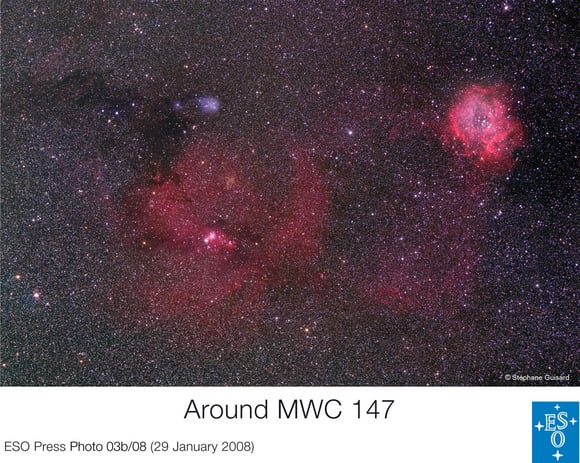Remember when you were young and how Mom always told you to eat everything on your plate so you would get big? Well, there's a young star heeding that advice about 2,600 light years from Earth in the constellation Monoceros. Known as MWC 147, this young stellar object is devouring everything on its "plate," the disk of gas and dust that surrounds it. Astronomers are witnessing how this star is gaining mass, and is on its way to becoming an adult.
Using the Very Large Telescope Interferometer, ESO (European Organization for Astronomical Research in the Southern Hemisphere) astronomers have peered into the disc of material surrounding MWC 147, witnessing how the star gains its mass as it matures. This star is increasing in mass at a rate of seven millionths of a solar mass per year. Ah, these young stars. It seems like they grow up so fast these days.
MWC 147 is less than half a million years old. If our 4.6 billion year old Sun is considered to be middle-aged, MWC 147 would be a 1-day-old baby. This star is in the family of Herbig Ae/Be objects. These are stars that have a few times the mass of our Sun and are still forming, increasing in mass by swallowing material present in a surrounding disc.
Being 6.6 times more massive than the Sun, however, MWC 147 will only live for about 35 million years, or to draw again the comparison with a person, about 100 days, instead of the 80 year equivalent of our Sun.
We're still learning about the morphology of the inner environment of these young stars, and everything we can discover helps us to better understand how stars and their surrounding planets form.
The observations by the ESO astronomers show that the temperature changes in this area are much steeper than predicted by current models, indicating that most of the near-infrared emission emerges from hot material located very close to the star, within one or two times the Earth-Sun distance (1-2 AU). This also implies that dust cannot exist so close to the star, since the strong energy radiated by the star heats up and ultimately destroys the dust grains.
"We have performed detailed numerical simulations to understand these observations and reached the conclusion that we observe not only the outer dust disc, but also measure strong emission from a hot inner gaseous disc. This suggests that the disc is not a passive one, simply reprocessing the light from the star," explained astronomer Stefan Kraus. "Instead, the disc is active, and we see the material, which is just transported from the outer disc parts towards the forming star."
Also of note is the beautiful image of the region surrounding MWC 147, which I'll post below. The number of stars in this image is incredible, and is reminiscent of the “grains of sand� comment by Carl Sagan. This is a wide field image taken by Stephane Guisard of ESO with a 200 mm lens.
Original News Source:
ESO Press Release
 Universe Today
Universe Today
